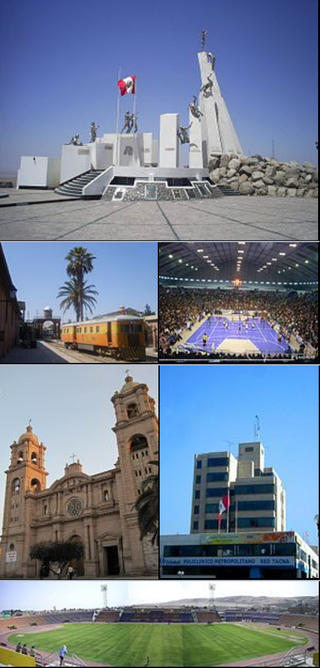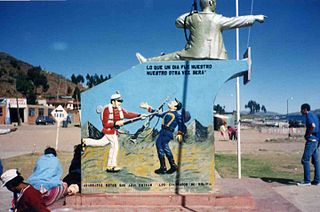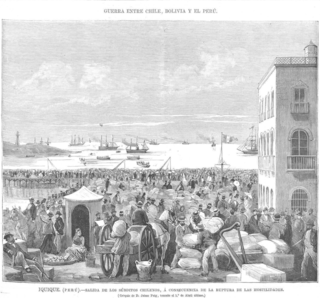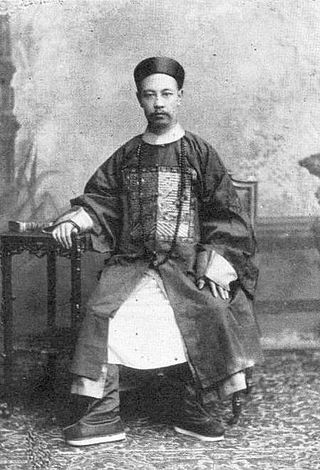See also
- Chinatowns in Latin America - about the Chinese community of Santiago
智利华人 | |
|---|---|
| Total population | |
| 13,528—17,021 by census 2017 [1] 20,000 with descendants [2] | |
| Regions with significant populations | |
| Northern Chile, Santiago, Chile | |
| Languages | |
| Chilean Spanish, Chinese | |
| Related ethnic groups | |
| Overseas Chinese |
It is estimated that there are over 20,000 Chinese people in Chile. [3] Chinese immigrants come from both China and Taiwan.
A high demand for manpower in the Southern South American region was present around the 1950s–1960s because of capitalism in the region. This demand for manpower also drew in a huge number of Chinese people coming to South America for work, which explains the huge increase of Chinese people 1950s–1960s. [4] This immigration was also present in the War of the Pacific with Chinese immigrating to both Peru and Chile to enlist into the war effort. After the war came to a close with a Chilean victor, people from Peru also settled in Chile. This was supportive due to the damages of the war done and they could work for construction of the infrastructure or just working inside factories. [5]
Between 1,200 and 1,500 Chinese workers in Peru offered support to the Chilean side in the War of the Pacific (1879–1883) and thus went to Chile at the war's end. [6]
Today the Chinese people living in Chile work primarily in trade and restaurant jobs. Although in Santiago one can find many local Chinese businesses, including importers, supermarkets, mini markets, malls (shopping centers such as Santiago Centro and Estación Central), Chinatowns are not concentrated in one place, except in the neighborhood of Patronato, where most of the Asian (i.e. mostly Chinese, Korean and Taiwanese) immigrants, niche businesses and supermarkets in Santiago are located. [ citation needed ]

Chile's 2017 census reported a population of 17,574,003 people. Its rate of population growth has been decreasing since 1990, due to a declining birth rate. By 2050 the population is expected to reach approximately 20.2 million people, at which point it is projected to either stagnate or begin declining. About 85% of the country's population lives in urban areas, with 40% living in Greater Santiago alone. The largest agglomerations according to the 2002 census are Greater Santiago with 5.6 million people, Greater Concepción with 861,000 and Greater Valparaíso with 824,000.

Tacna, officially known as San Pedro de Tacna, is a city in southern Peru and the regional capital of the Tacna Region. A very commercially active city, it is located only 35 km (22 mi) north of the border with Arica y Parinacota Region from Chile, inland from the Pacific Ocean and in the valley of the Caplina River. It is Peru's tenth most populous city.

Chinese Peruvians, also known as tusán, are Peruvian citizens whose ancestors came from China.
Chinatowns in Latin America developed with the rise of Chinese immigration in the 19th century to various countries in Latin America as contract laborers in agricultural and fishing industries. Most came from Guangdong Province. Since the 1970s, the new arrivals have typically hailed from Hong Kong, Macau, and Taiwan. Latin American Chinatowns may include the descendants of original migrants — often of mixed Chinese and Latino parentage — and more recent immigrants from East Asia. Most Asian Latin Americans are of Cantonese and Hakka origin. Estimates widely vary on the number of Chinese descendants in Latin America but it is at least 1.4 million and likely much greater than this.

Roto, f. rota, is a term used to refer to Chilean people and in particular to the common Chilean. In Chile, from the start of the 20th century, it was applied with a negative classist connotation to poor city-dwellers. It is also used contemptuously in other Spanish-speaking countries, especially Bolivia and Peru, to refer to Chileans in a derogatory manner. Otherwise, despite its defects, the roto is also considered a figure of national identity and pride in Chile.
Asian Latin Americans are Latin Americans of Asian descent. Asian immigrants to Latin America have largely been from East Asia or West Asia. Historically, Asians in Latin America have a centuries-long history in the region, starting with Filipinos in the 16th century. The peak of Asian immigration occurred in the 19th and 20th centuries. There are currently more than four million Asian Latin Americans, nearly 1% of Latin America's population. Chinese, Japanese, and Lebanese are the largest Asian ancestries; other major ethnic groups include Filipinos, Syrians, Indians, and Koreans. Brazil is home to the largest population of East Asian descent, estimated at 2.08 million. The country is also home to a large percentage of West Asian descendants. With as much as 5% of their population having some degree of Chinese ancestry, Peru and Mexico have the highest ratio of any country for East Asian descent. Though the most recent official census, which relied on self-identification, gave a much lower percentage.

Chifa is a Chinese Peruvian culinary tradition based on Cantonese elements fused with traditional Peruvian ingredients and traditions. The term is also used to refer to restaurants that serve the chifa cuisine.

Barrio chino is a neighborhood in Lima, Peru that is centered on two blocks – 7 and 8 – of Jirón Ucayali in downtown. The neighborhood was founded in the mid-19th century by Chinese immigrants, but it was heavily damaged in the late 19th century by the War of the Pacific and further declined in the following decades. It experienced a revival starting in the 1970s and is now a thriving resource for Chinese-Peruvian culture.
German Chileans are Chileans descended from German immigrants, about 30,000 of whom arrived in Chile between 1846 and 1914. Most of these were from Bavaria, Baden and the Rhineland, and also from Bohemia in present-day Czech Republic, which were traditionally Catholic. A smaller number of Lutherans immigrated to Chile following the failed revolutions of 1848.
Immigration to Chile has contributed to the demographics and the history of this South American nation. Chile is a country whose inhabitants are mainly of Iberian, mostly of Andalusian and Basque origin, and Native American, mostly descended from Mapuche peoples. A moderate numbers of European immigrants settled in Chile during the 19th and 20th centuries, mainly Spanish, as well as Germans, British, French, Southern Slavs, and Italians who have made additional contributions to the racial complex of Chile. However, this immigration was never in a large scale, contrasting with mass migrations that characterized Argentina, Uruguay and southern Brazil, and therefore, anthropologically, its impact with lesser consequence. At the same time, some separate cultural aspects, such as German cakes, British afternoon tea, and Italian pasta, were preserved. The fusion is also visible in the architecture of Chilean cities. This intermarriage and mixture of cultures and races have shaped the present society and culture of Chile.

A Spanish Peruvian is a Peruvian citizen of Spanish descent. Among European Peruvians, the Spanish are the largest group of immigrants to settle in the country.

Spanish Chileans refer more often to Chileans of post-independence Spanish immigrant descent, as they have retained a Spanish cultural identity. People of pre-independence Spanish descent are usually not considered Spanish Chileans even though they form a large majority of the Chilean population and have Spanish surnames and ancestry. This is because they rejected Spanish identity for the emergent Chilean one on the eve of national independence.

Anti-Chilean sentiment or chilenophobia refers to the historical and current resentment towards Chile, Chileans, or Chilean culture. Anti-Chilean sentiment is most prevalent among Chile's neighbors Argentina, Bolivia and Peru.

The Spanish diaspora consists of Spanish people and their descendants who emigrated from Spain. In the Americas, the term may refer to those of Spanish nationality living there; "Hispanic" is usually a more appropriate term to describe the general Spanish-speaking populations of the Americas together with those in Spain. The diaspora is concentrated in places that were part of the Spanish Empire. Countries with sizeable populations are Argentina, Bolivia, Chile, Colombia, Costa Rica, Cuba, Dominican Republic, Ecuador, El Salvador, Guatemala, Honduras, Mexico, Nicaragua, Panama, Paraguay, Peru, Uruguay, Venezuela, and, to a lesser extent, Brazil, Belize, Haiti, United States, Canada, the Philippines and the rest of Europe.
Illegal immigration in Chile is a phenomenon that largely began in the 1990s as a result of economic growth and political stability in Chile. Most immigrants are South American, with the largest wave being Peruvian, although there has also been a significant amount of migration from the Caribbean. Illegal immigration is primarily caused by a lack of security or economic opportunities in the country of origin.
During most of Chile's history, from 1500 to the present, mining has been an important economic activity. 16th century mining was oriented towards the exploitation of gold placer deposits using encomienda labour. After a period of decline in the 17th century mining resurged in the 18th and early 19th century this time revolving chiefly around silver. In the 1870s silver mining declined sharply. Chile took over the highly lucrative saltpetre mining districts of Peru and Bolivia in the War of the Pacific (1879–83). In the first half of the 20th century copper mining overshadowed the declining saltpetre mining.

The Expulsion of Chileans from Bolivia and Peru in 1879 was an ethnic cleansing ordered by of the governments of Bolivia and Peru. The expulsion took place at the beginning of the War of the Pacific (1879-1883) between Chile and Peruvian-Bolivian alliance. Chilean citizens in both nations were ordered to leave within eight days or face internment and confiscation of their property. They were expelled on poorly-built rafts and pontoons at Peruvian ports, or forced to wander through the desert to reach the northernmost positions occupied by the Chilean Army in Antofagasta. The edict was widely popular in Peru and met with little resistance, allowing it to occur quickly.
Racism in Chile encompasses any type of racial or ethnic discrimination by a group of inhabitants or organizations of that country against groups from other nations or the same nation. The origins of Chilean racism, and that of other Latin American nations, can be traced back to 16th century colonialism under the rule of the Spanish Empire. In the establishment of imperial rule, Native Americans experienced extermination, slavery and forced miscegenation.

Quintín Quintana Lauchen, born Liu Tang Sin Shin, Leotàn Sin-Shin, or Leo Shin, was a Chinese-Peruvian, later Chinese-Chilean, merchant and police detective. Born in China, he worked as a coolie in Peru and took a Spanish-language name. During the War of the Pacific, fought by Peru and Bolivia against Chile, Quintana joined the Chilean intelligence service and led a Chinese émigré collaboration effort against the Peruvian government.